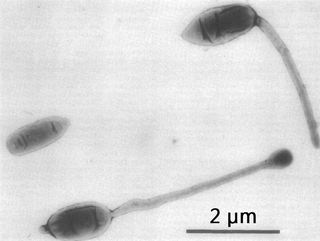
The Hyphomicrobiaceae are a family of bacteria. Among others, they include Rhodomicrobium, a genus of purple bacteria.
Chromohalobacter is a gram negative, oxidase and catalase positive, rod shaped, motile marine Pseudomonadota. It is commonly found in marine environments. Two species of Chromohalobacter was isolated from marine sponges of the Saint Martin's Island area of the Bay of Bengal, Bangladesh. Colonies are medium-sized, round and yellowish. It was established by Ventosa and others in 1989, with the reclassification of Chromobacterium marismortui as Chromohalobacter marismortui. As of 2007, it comprised the following species:
Virgibacillus carmonensis is a bacterium. It is Gram-positive, rod-shaped and moderately halophilic, originally isolated from deteriorated mural paintings. LMG 20964T is its type strain.
Virgibacillus necropolis is a bacterium. It is Gram-positive, rod-shaped and moderately halophilic, originally isolated from deteriorated mural paintings. LMG 19488T is its type strain.
Aestuariibacter aggregatus is a gram-negative, strictly aerobic, non-spore-forming, catalase- and oxidase-positive, from the genus of Aestuariibacter with a single polar flagellum which was isolated from the Yellow Sea in China.
Aestuariibacter halophilus is a gram-negative, strictly aerobic, halophilic, catalase- and oxidase-positive, rod-shaped bacterium from the genus of motile Aestuariibacter with a single polar flagellum which was isolated from the Ganghwa island in Korea.
Gracilibacillus is a genus of bacteria within the phylum Bacillota. Species within this genus are generally halotolerant.
Virgibacillus is a genus of Gram-positive, rod-shaped (bacillus) bacteria and a member of the phylum Bacillota. Virgibacillus species can be obligate aerobes, or facultative anaerobes and catalase enzyme positive. Under stressful environmental conditions, the bacteria can produce oval or ellipsoidal endospores in terminal, or sometimes subterminal, swollen sporangia. The genus was recently reclassified from the genus Bacillus in 1998 following an analysis of the species V. pantothenticus. Subsequently, a number of new species have been discovered or reclassified as Virgibacillus species.
Virgibacillus salexigens is a species of Gram-positive bacteria.
Thermolithobacteria is a class of rod-shaped Gram-positive bacteria within phylum Bacillota. Species within this class are thermophilic lithotrophs isolated from sediment in Calcite Springs in Yellowstone National Park. Thermolithobacter ferrireducens strain JW/KA-2(T) metabolism consists of the oxidation of hydrogen gas and reduction of ferric oxide to magnetite. Thermolithobacter carboxydivorans strain R1(T) is hydrogenic and oxidizes carbon monoxide.
Alteriqipengyuania lutimaris is a Gram-negative, oval-shaped and non-motile bacteria from the genus Alteriqipengyuania which has been isolated from tidal flat sediment from the Yellow Sea in Korea.
Chryseomicrobium is a bacteria genus from the family of Planococcaceae.
Cyclobacterium is a mesophilic, neutrophilic, chemoorganotrophic and aerobic bacterial genus from the family of Cyclobacteriaceae. Cyclobacterium bacteria occur in marine habitats
Domibacillus is a genus of bacteria from the family of Bacillaceae.
Salimicrobium is a genus of bacteria from the family of Bacillaceae.
Salimicrobium salexigens is a Gram-positive, moderately halophilic, strictly aerobic and non-motile bacterium from the genus of Salimicrobium which has been isolated from salted cowhide from Istanbul in Turkey.
Rheinheimera salexigens is a Gram-negative and rod-shaped bacterium from the genus of Rheinheimera which has been isolated from a fishing hook from Oahu.
Virgibacillus marismortui is a Gram-positive, moderately halophilic and rod-shaped bacterium which has been isolated from water from the Dead Sea.
Prolixibacteraceae is a family of 11 bacterial genera in the order of Bacteroidales.
The Temperatibacteraceae are a family of bacteria.
